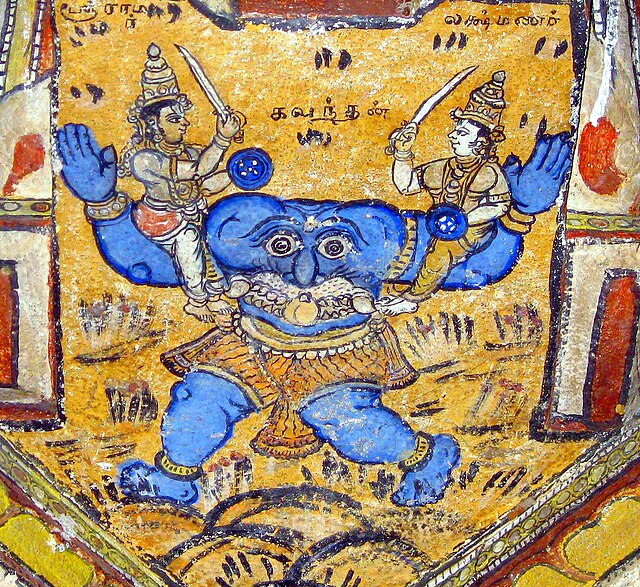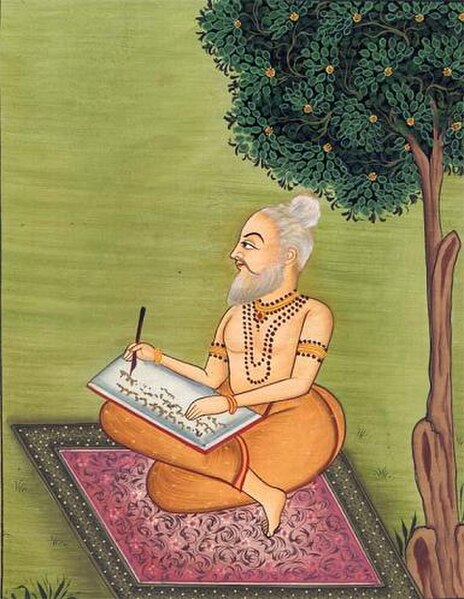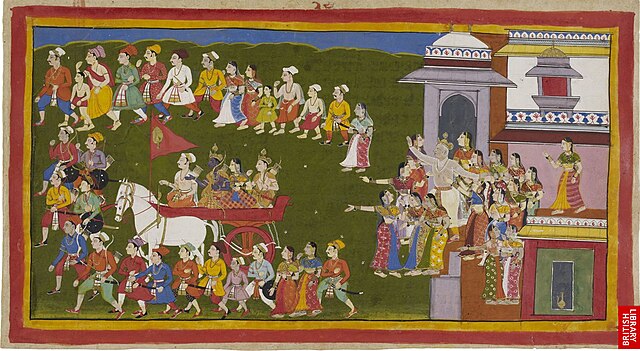In Hinduism, Kabandha is a Rakshasa (demon) who is killed and freed from a curse by the god Rama – an Avatar of Vishnu – and his brother Lakshmana. Kabandha's legend appears in the Hindu epics Ramayana and Mahabharata, as well as in later Ramayana adaptations.
Rama and Lakshmana seated on Kabandha's arms, about to sever them. Kabandha is depicted with a big mouth on his stomach and no head or neck; though depicted with two eyes, the Ramayana describes him as one-eyed. (Painting on the ceiling of Kodandaramaswamy Temple, Ayodhyapatinam near Salem, probably 16th-century.)
Kabandha was born as a Gandharva – a celestial musician (right) here pictured with an Apsara, celestial dancer. (10th-century Cham "Dancers' Pedestal" of the Tra Kieu style.)
Rama (left) and Lakshamana seated on the arms of Kabandha, about to sever his arms, a 19th-century painting from Tiruchchirappalli.
The exiled princes Rama and Lakshamana were caught by Kabandha, whose arms they severed.
The Ramayana, also known as Valmiki Ramayana, as traditionally attributed to Valmiki, is a smriti text from ancient India, one of the two important epics of Hinduism known as the Itihasas, the other being the Mahabharata. The epic narrates the life of Rama, a prince of Ayodhya in the kingdom of Kosala. The epic follows his fourteen-year exile to the forest urged by his father King Dasharatha, on the request of Rama's stepmother Kaikeyi; his travels across forests in the Indian subcontinent with his wife Sita and brother Lakshmana; the kidnapping of Sita by Ravana, the king of Lanka, that resulted in war; and Rama's eventual return to Ayodhya along with Sita to be crowned king amidst jubilation and celebration.
An artist's impression of sage Valmiki composing the Ramayana
Rama (left third from top) depicted in the Dashavatara, the ten avatars of Vishnu. Painting from Jaipur, now at the Victoria and Albert Museum
The marriage of the four sons of Dasharatha with the four daughters of Siradhvaja Janaka and Kushadhvaja. Rama and Sita, Lakshmana and Urmila, Bharata and Mandavi and Shatrughna with Shrutakirti. Folio from the Shnagri Ramayana, early 18th-century. National Museum, New Delhi
Rama leaving for fourteen years of exile from Ayodhya.







